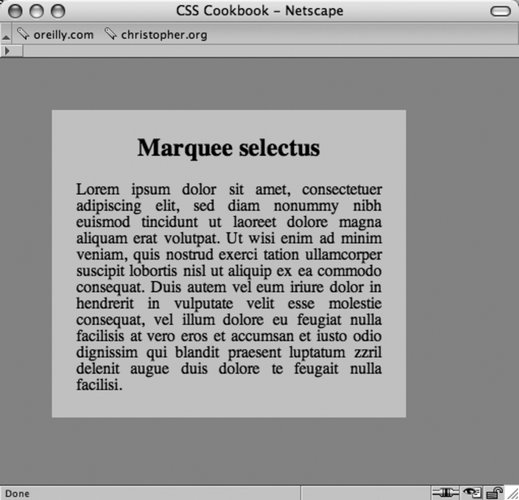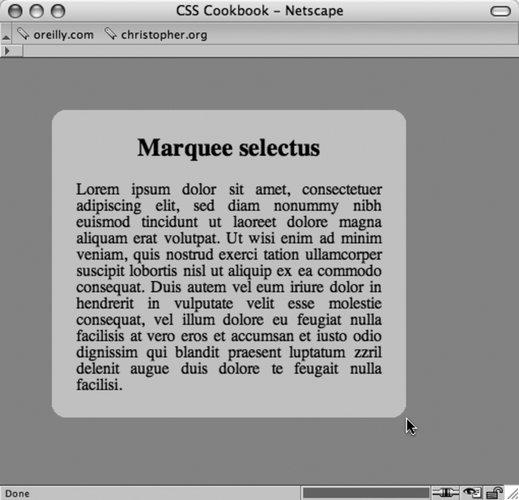Recipe 3.17. Rounding Corners with JavaScript
ProblemYou want to include rounded corners on elements without the hassle of introducing new markup or images manually. SolutionUse Nifty Corners Cube code by Alessandro Fulciniti. First down the components of the Nifty Corners Cube solution, which include one CSS and one JavaScript file, at http://www.html.it/articoli/niftycube/NiftyCube.zip. Upload both the JavaScript and CSS files associated with the Nifty Corners Cube solution. Then link the JavaScript to the web page by using the src attribute in the script element: <script type="text/javascript" src="/books/3/27/1/html/2//_assets/js/niftycube.js"></script>
Next modify the markup that will have rounded corners (see Figure 3-42) by giving it a unique value in the id attribute: <div > <h2>Marquee selectus</h2> <p>...<p> </div> Figure 3-42. Default rendering of the column Next, make a separate JavaScript call to tell the browser which element gets the rounded corners and then define the size of the rounded corners (see Figure 3-43): <script type="text/javascript" src="/books/3/27/1/html/2/niftycube.js"></script> <script type="text/javascript"> window.onload=function( ) { Nifty("div#box","big"); } </script>Figure 3-43. The rounded corners appear DiscussionSince it's almost a completely worry-free method for creating rounded corners, the Nifty Corners Cube solution has been called more of a tool than a technique. Different colorsColors are detected automatically. The JavaScript automatically changes the colors to match the background color within the element as well as its parent element (usually the body of the web page). This means a developer only has to be worried with setting which element gets the curves and the size. Different sizesThere are four keywords sizes written in to the Nifty Corners Cube JavaScript: none, small, normal (default), and big. Small is equal to the value of 2 pixels, normal is 5 pixels and big is 10 pixels. For example, to adjust the corners so that they are small, the JavaScript call would look like: <script type="text/javascript"> window.onload=function( ) { Nifty("div#box","small"); } </script>Different elementsNifty Corners Cube accepts numerous selectors making it easier to dictate which elements should receive rounded corners; the selectors are listed in Table 3-1.
For example, to apply rounded corners to multiple elements, the JavaScript function may look like this: <script type="text/javascript"> window.onload=function( ) { Nifty("div, h3.main div, p","small"); } </script>Specific cornersThe Nifty Corners Cube also makes allowances for developers who may not want to apply rounded edges to all the corners. Table 3-2 lists the keywords that allow developers to single out which corner or corners to round.
For example, to apply rounded corners to just the top corners of multiple elements within a web page, the JavaScript function may look like the following: <script type="text/javascript"> window.onload=function( ) { Nifty("div, h3.main div, p","small top"); } </script>See AlsoFor more information about Nifty Corners Cube at http://www.html.it/articoli/niftycube/index.html. |
EAN: 2147483647
Pages: 235
